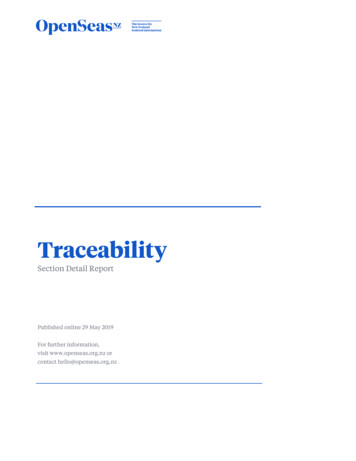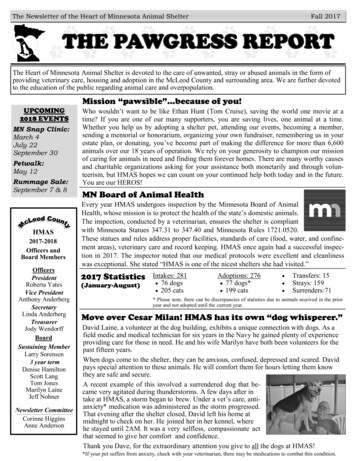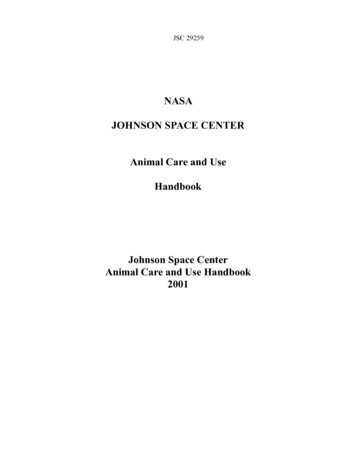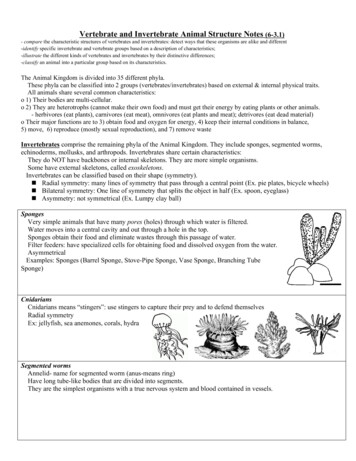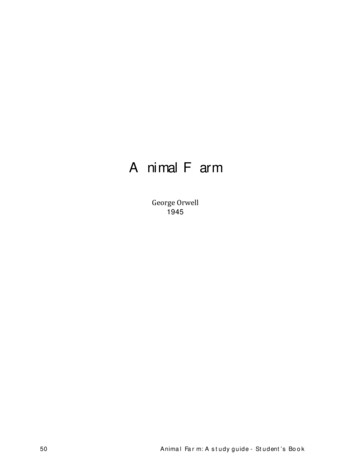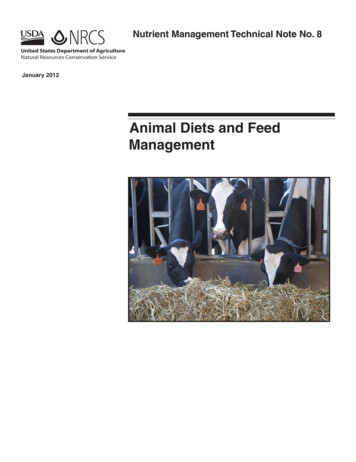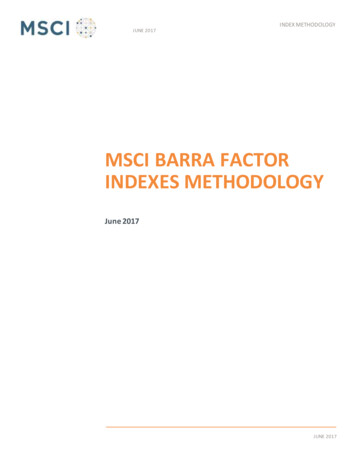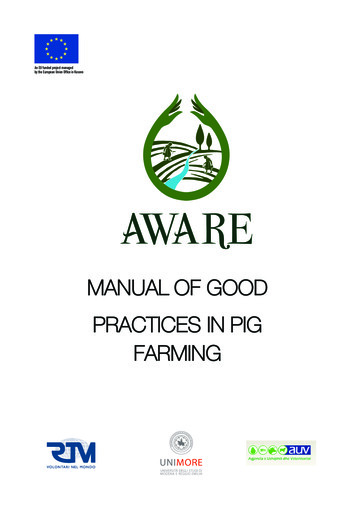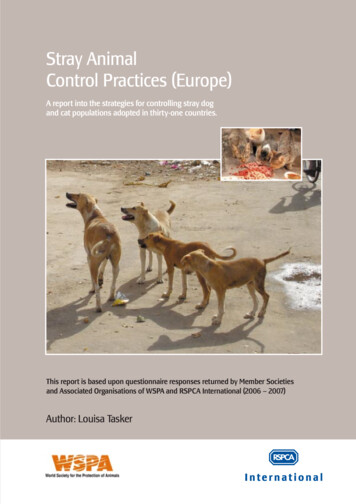
Transcription
Stray AnimalControl Practices (Europe)A report into the strategies for controlling stray dogand cat populations adopted in thirty-one countries.This report is based upon questionnaire responses returned by Member Societiesand Associated Organisations of WSPA and RSPCA International (2006 – 2007)Author: Louisa Tasker
PREFACEThis project was commissioned by the World Society for the Protection of Animals (WSPA) and the RoyalSociety for the Prevention of Cruelty to Animals International (RSPCA International). It was intended toupdate an existing study of dog population control practices across Europe conducted by RSPCAInternational, in 1999. Furthermore the present survey also included questions on the control of straycats. In addition to the questionnaire, a small number of case study countries were reviewed in anattempt to document their progression towards successful stray dog control.World Society for the Protection of Animals (WSPA)89 Albert EmbankmentLondonSE1 7TPTel: 44 (0)20 7587 5000Fax: 44 (0)20 7793 0208Email: wspa@wspa.org.ukwww.wspa-international.orgRSPCA InternationalWilberforce WaySouthwaterHorshamWest SussexRH13 9RSTel: 44 (0)870 7540 373Fax: 44 (0)870 7530 059Email: international@rspca.org.uki
ii
ACKNOWLEDGEMENTSI am sincerely grateful to Dr Elly Hiby (WSPA) and David Bowles (RSPCA International) for theirmanagement of the project. I would like to thank Rachel Smith and Mike Appleby at WSPA for theircomments on previous drafts of this report. In addition Alexandra Hammond-Seaman, Gareth Thomasand Corralie Farren at RSPCA International made suggestions for improvements and provided furtherinformation for inclusion.Particular appreciation must be expressed to the WSPA member societies and RSPCA Internationalcontacts and associated organisations that completed questionnaires regarding stray dog and catpopulation control in their countries:AlbaniaArmeniaAzerbaijan RepublicBelarusBelgiumBosnia ction and Preservation of the Natural Environment in Albania (PPNEA)Azerbaijan Society for the Protection if Animals (AZSPA)Society for the Protection of Animals “Ratavanne”Chaine Bleue Mondiale(Bos-Her)Bulgaria(Bul)Croatia*(Cro)Czech Republic*(Cz. eeceHungaryIrelandItalyLithuaniaMaltaMoldovaThe )(Ser)Slovenia(Slov)Society for the Prevention of Cruelty to Animals, SOS, Sarajevo*State Veterinary Office of Bosnia and HerzegovinaSociety for the Protection of Animals; VARNAIntimate with Nature SocietyEkoravnovesieDrustvo Za Zastitu Zivotinja Rijeka;Society for Animal Protection Rijeka*The City of Zagreb Department of Agriculture and Forestry*Ministry of Agriculture Forestry and Water Management (Zagreb)*RSPCA Consultant, Central Commission for Animal Protection, Ministry ofAgricultureDyrenes Beskyttelse; Danish Animal Welfare SocietyEstonian Society for the Protection of AnimalsSuomen Elainsuojeluyhdistys SEY ry;Finish Society for the Protection of Animals Helsingin Elainsuojeluyhdstys re;Helsinki Humane Society*Evira; Finnish Food Safety AuthorityBundesverband Tierschutz e.V.Greek Animal Welfare SocietyRex Dog Shelter FoundationIrish Society for the Prevention of Cruelty to Animals (ISPCA)Lega Pro AnimaleLithuanian Society for the Protection of Animals (LiSPA)Society for the Protection and Care of Animals (SPCA) MaltaTRISAN Association of Nature and Animal ProtectionNederlandse Vereniging Tot Bescherming van Dieren;Dutch Society for the Protection of AnimalsNorwegian Animal Welfare Alliance (NAWA)Ogólnopolskie Towarzystwo Ochrony Zwierz t (OTOZ) Animals*General Veterinary InspectorateAssociacão Nortenha de Intervencão no Mundo Animal (ANIMAL)Drustvo Prijatelja Zivottinja (Ljubimic)The Society for the Protection of Animals – PancevoSociety for the Protection of Animals Ljubljanaiii
Spain*(Spa)Sweden(Swe)SwitzerlandUkraineUnited Kingdom(Swi)(Ukr)(UK)Fundacion FAADA*Direccao Geral de VeterinariaDjurskyddet Sverige; Animal Welfare SwedenSvenska DjurkyddsforeningenSchweizer Tierschutz STS; Swiss Animal Protection (SAP)CETA Centre for the Ethical Treatment of Animals “LIFE”Royal Society for the Prevention of Cruelty to Animals (RSPCA)Dogs Trust* Additional responses were supplied by municipal or veterinary authorities in some instances.The following people and organisations are gratefully acknowledged for their assistance with gathering information on thecase study countries during winter 2006:SloveniaUrska Markelj, Society for the Protection of Animals, LjubljanaSwedenLena Hallberg, Animal Welfare SwedenAurora Sodberg, ManamalisJohan Beck-Friis, Swedish Veterinary AssociationSwitzerlandDr. Eva Waiblinger, Schweizer Tierschutz STSUnited KingdomRoyal Society for the Prevention of Cruelty to Animals (RSPCA)Chris Laurence and Emma West at the Dogs Trustiv
TABLE OF CONTENTSACKNOWLEDGEMENTSTABLE OF CONTENTSSUMMARY1. INTRODUCTION1.1. Definitions of stray dogs and cats1.2. Problems associated with stray dogs and cats1.3. The need for control1.4. Introduction to the report1.4.1. Aim of the questionnaire survey1.4.2. Specific objectives2. METHODOLOGY2.1. General method2.2. Contents of the questionnaire2.3. Selection of countries for more detailed investigation3. RESULTS3.1. Response rate3.2. Legislation3.2.1. Pet ownership3.2.2. Breeding and selling3.2.3. Abandonment, stray animals, stray collection3.2.4. Dangerous dogs3.3. Stray control3.3.1. Dogs3.3.1.i. Population trends3.3.1.ii. Source of stray dogs3.3.1.iii. Methods of stray dog control3.3.2. Cats3.3.2.i. Population trends3.3.2.ii. Source of stray cats3.3.2.iii. Methods of stray cat control3.4. Euthanasia3.5. Neutering3.6. Owner education3.7. Characteristics of countries surveyed and their approaches to stray dog control3.8. Comparisons to the previous study undertaken in 19993.8.1. Changes in legislation3.8.2. Changes in compulsory registration or licensing of dogs anddog identification3.8.3. Responsibility for stray control3.9. Case studies: Examples of successful control3.9.1. Slovenia3.9.1.1. The situation in 61919192325252525262626v
3.9.1.2. Legislation3.9.1.3. Registration and licensing3.9.1.4. Responsibility for strays3.9.1.5. The owned dog population3.9.1.6. Origins of the “stray” dog population3.9.1.7. Additional factors3.9.1.8. Concluding remarks3.9.2. Sweden3.9.2.1. The situation in Sweden3.9.2.2. Legislation3.9.2.3. Registration and licensing3.9.2.4. Responsibility for strays3.9.2.5. The owned dog population3.9.2.6. Origins of the “stray” dog population3.9.2.7. Additional factors3.9.2.8. Concluding remarks3.9.3. Switzerland3.9.3.1. The situation in Switzerland3.9.3.2. Legislation3.9.3.3. Registration and licensing3.9.3.4. Responsibility for strays3.9.3.5. The owned dog population3.9.3.6. Origins of the “stray” dog population3.9.3.7. Additional factors3.9.3.8. Concluding remarks3.9.4. United Kingdom3.9.4.1. The situation in the United Kingdom3.9.4.2. Legislation3.9.4.3. Registration and licensing3.9.4.4. Responsibility for strays3.9.4.5. The owned dog population3.9.4.6. Origins of the “stray” dog population3.9.4.7. Additional factors3.9.4.8. Concluding remarks4. CONCLUSIONS5. REFERENCES6. APPENDIXAppendix 1: Questionnaire sent as an email attachment: Stray dog and cat control in Europe:WSPA/RSPCA QuestionnaireAppendix 2: RSPCA International stray dog postal questionnaire 1999Appendix 3: Results of RSPCA International postal survey of stray dog control practicesin Europe, 1999Appendix 4: Questionnaire respondentsAppendix 5: The Results of the Polish Chief Veterinary Officer on Polish Shelters forHomeless Animals (2001 – 13132323232323335353637383940414146485054
SUMMARYThirty-four animal welfare groups operating in thirty countries (located in Europe and Eurasia*)responded to a questionnaire on the control of stray dogs and cats in their country during winter 2006and spring 2007. In addition, information was gained from an RSPCA International consultant workingin the Czech Republic and municipal or veterinary authorities in five countries (Bosnia-Herzegovina,Croatia, Finland, Poland and Spain) during autumn and winter 2007. The survey aimed to:(1) Document the methods of stray dog and cat population control in Europe* based upon responses byWSPA member societies and RSPCA International associated organisations.(2) Update an existing RSPCA International document outlining stray animal control measures.(3) Select a limited number of case study countries and document their progression towards andmethods adopted for effective stray population control.FINDINGSIt should be noted that this report has been complied on the basis of majority responses received fromanimal welfare groups working in their respective countries. Very little numerical data or evidence couldbe provided by respondents (there is a universal lack of this type of data collected by authorities) toverify how successful/unsuccessful the reported control measures were at reducing stray dog and catnumbers. The questionnaire asked for respondents opinions on various aspects of stray control andthese are reflected in the report. Hence the reports findings should be interpreted with care. Similarlywith case study countries the lack of census, population information and historical data madeconstructing a time line of initiating events that corresponded to reducing stray numbers impossible.Summary of resultscontrol methods varied greatly across those countries surveyed. StrayNo census or population data was systematically recorded nationally by a central (government) bodyfor owned or stray dogs and cats.Trends in stray dogs numbers over the last five years9%9%26%No informationDecreased13%IncreasedRemained constantWhere given (41%: N 13) the sourceof strays was reported to be dogsthat were owned (not under closeowner control: i.e. loose or lost) orunwanted (intentionally dumped).No stray dogs43%Que 6 (a). Has the number of stray dogs increased, decreased or stayed the same over the last five years?*Note that WSPA‘s European regional division includes Eurasian countries such as Armenia and Azerbaijan Republic. Member societiesoperating in these countries were also contacted for information regarding stray control and their responses are included in this report.vii
Reported methods of stray dog control10%3%Not StatedCNR19%52%CombinationCulledCaught16%The statutory holding period varied greatly (range:3 – 60 days) in those countries that caught straydogs. In addition, of those countries that caughtstrays 10 (32%) euthanised animals that were notre-claimed or could not be re-homed after theholding period; 2 (6%) euthanised all animals uponcapture (without waiting for the holding period toelapse) and 3 (10%) countries did not (legally)permit the killing of healthy stray dogs requiringlife-long care to be provided in the event that theycould not be re-homed.Que 7 (a). How is the stray dog population controlled in your country?Caught: Dogs found not under close control are caught; Culled; Dogs are culled in situ (by shooting); Combination: A number ofdifferent approaches were adopted; CNR: Catch Neuter and Release – dogs are caught, neutered and re-released; Not Stated:Information not given by the respondent.countries where dog registration and licensing were rigorously enforced it was considered by Inrespondentsto be an essential element in successful stray control practices.Despite compulsory registration and licensing in 70% (N 22) of countries, in 48% (N 15) of countries animal owners were not compliant and the authorities did not enforce the regulations. Stray cats were less likely to be subjected to systematic control by authorities than stray dogs.Trends in stray cats numbers over the last five years23%No information39%3%DecreasedIncreasedRemained constantSource of strays was not reported by 51%(N 16) of respondents. Six countries (19%)reported the majority of stray cats werepresumed to be the offspring of theprevious generation of strays i.e. they hadnever been owned.35%Que 6 (a). Has the number of stray cats increased, decreased or stayed the same over the last fiveyears?viii
Reported methods of stray cat control3%13%20%Not StatedCNRCombination20%44%CulledCaughtQue 7 (a). How is the stray cat population controlled in your country?Caught: Cats are caught; Culled; Cats are culled where they are found; Culled and other: Under certain circumstances cats may beculled, or caught; CNR and caught: Catch Neuter and Release – cats are caught, neutered and re-released in certain circumstances orthey may be caught and re-homed as appropriate; CNR: Catch Neuter and Release – cats are caught, neutered and re-released; NotStated: information not given by the respondent.cats were more likely to be reported to be culled than stray dogs. StrayThe implantation of a microchip was cited as the most popular form of identification.When monitored (only given by 6 respondents) owner education schemes were reported to be successfulin changing owner attitudes (4 respondents), increased the likelihood of owners getting their pets neutered (2 respondents) and resulted in a decrease in the number of stray dogs (1respondent).From information provided by case study countries - successful stray control appears to be related toa number of elements: comprehensive, effective and enforced legislation, registration and licensing,control of breeding and sale, environmental management, owner education and good cooperationbetween authorities and animal welfare groups.ix
x
1. INTRODUCTION1.1. Definitions of stray dogs and catsa) Stray dogsDefinitions of stray dogs are inherently problematic and judgements regarding when a dog isconsidered to be a stray varies from country to country and may be subject to local and nationalregulations (see Table 1, for three classifications of dogs considered “stray”). Indeed any dog, foundunaccompanied by a responsible person in a public place may, in some countries, be considered asstray and collected accordingly. Conversely, at the other end of the scale, unwanted dogs; dogs, whoseowners have revoked all care giving responsibilities, may, if they survive for long enough, be able toreproduce and rear young. Though this generation of dogs may be considered to be genuinelyownerless and in some instances feral, their survival rates are invariably low and their reproductivesuccess is likely to be poor. They are therefore not considered to be the main source ofoverpopulation. Somewhere between the two examples, dogs may be cared for by one or moremembers of a community, allowed to roam and permitted to reproduce. Nevertheless, they aregenuinely dependent upon human caregivers, as they provide access to the resources essential fortheir survival. The reproduction rates of these dogs and their rearing success has the potential to behigh because care given by humans offers the necessary protection for puppy survival (c.f.International Companion Animal Management Coalition, 2007 for characterisation of dogs in terms oftheir ownership status, p: 5).In summary, feral dogs, those that are truly independent of human care givers are rarelyconsidered to be salient contributors to the problem of strays.b) Stray catsThe relationship between cats and their caretakers is intrinsically different to dogs, although thesame set of associations may apply but to varying degrees (Table 1). Indeed cats can and will changelifestyles during their lifespan.1.2. Problems associated with stray dogs and catsStray animals, often experience poor health and welfare, related to a lack of resources or provision ofcare necessary to safeguard each of their five freedoms. Furthermore, they can pose a significantthreat to human health through their role in disease transmission. A summary of the problemsarising from stray dogs and cats is given in Table 2.1
Table 1. Classification of dogs and cats by their dependence upon humansClassificationDogsCatsSTRAY –The following3* terms maybe used toclassify straydogs and cats:No owners or caretakersUn-owned, independent of human controlGenerally derived from dog populations undersome degree of human care “gone wild”Poorly socialized to human handlingFound on the outskirts of urban and rural areasSub-population of free roaming cats (may beoffspring from owned or abandoned cats)*FeralPoorly socialized to human handlingSurvive by scavengingSurvive through scavenging and huntingPoor survival ratesLow reproductive capacity*Abandoned/unwanted bytheir ownersWere once dependent on an owner for careWere once dependent on an owner for careOwner is no longer willing to provide resourcesOwner is no longer willing to provide resourcesMay or may not be fed by other members of thecommunity (food may be delivered intermittently)May or may not be fed by other members of thecommunity (food may be delivered intermittently)Survive by scavenging (or hunting)Survive by scavenging or huntingPoor survival prospects once there is no longer acaretaker to provide food or shelterMay or may not be socialized to human handling*OwnedFree-roaming dogsnot controlled“Latch-key” dogsFree roaming cats“Kept” outdoorsCommunity or neighbourhood dogsOwnedcontrolledEither entirely free to roam or may be semirestricted at particular times of the dayEither entirely free to roam or may be semi-restrictedat particular times of the dayDependent upon humans for resourcesDependent upon humans for some of their resourcesMay or may not be sterilizedMay or may not be sterilizedPotential for high reproductive capacity andrearing ratesPotential for high reproductive capacity andrearing ratesTotally dependent upon an owner for care andresourcesTotally dependent on an owner for care and resourcesGenerally under close physical control of the ownerMay vary from totally indoor to indoor/outdoor,outdoor but confined to pen or gardenConfined to the owners property or under controlwhen in public placesReproduction usually controlled through sterilization, Generally reproduction may be controlled throughchemical means or confinementsterilization or confinement2
1.3. The need for controlIt is important to develop long-term, sustainable strategies to deal effectively with stray animalpopulations. This is essential not only to protect humans from coming into contact with thoseanimals but to protect the health and welfare of the animals themselves. Experience shows thateffective control involves the adoption of more than one approach (WHO/WSPA, 1990; InternationalCompanion Animal Management Coalition, 2007). In Western societies, where the concept of“ownership” predominates, it requires a comprehensive, coordinated and progressive programme ofowner education, environmental management, compulsory registration and identification, controlledreproduction of pets and the prevention of over production of pets through regulated breeding andselling. All of these elements should be underpinned by effective and enforced legislation. Toimplement these elements successfully requires the involvement of more than one agency; and inturn is dependent upon the willingness of government departments, municipalities, veterinaryagencies and non government organisations (NGO’s) to work together.1.4. Introduction to the projectStray dogs and cats may experience poor welfare; scavenging for food, competing for limitedresources and lack of veterinary care result in malnutrition, injury and disease. Furthermore, strayanimals pose a significant threat to human health by acting as vectors of disease. It is importanttherefore, to adopt approaches that deal effectively with stray animal populations.The World Society for the Protection of Animals (WSPA) in collaboration with the Royal Society forthe Prevention of Cruelty to Animals International (RSPCA International) proposed a survey of theirmember societies and associated organisations to gather information on stray animal controlmeasures within Europe*. The specific aim and objectives of the project are detailed below:1.4.1. Aim of the questionnaire survey(1) To produce a report that documents the methods of stray dog and cat population control inEurope* based upon responses provided by member society and associated organisations.1.4.2. Specific objectives(1) To update an existing RSPCA International document outlining stray animal control measuresin Europe.(2) To select a limited number of the most successful Countries for more detailed case studies.(3) To describe in detail the selected countries’ progression towards and methods adopted for effectivestray population control.*Note that WSPA‘s European regional division includes Eurasian countries such as Armenia and Azerbaijan Republic. Member societiesoperating in these countries were also contacted for information regarding stray control and their responses are included in this report.3
Table 2. Problems associated with stray dogs and catsFactorDogsCatsPublic Health1. Zoonosis– Diseasetransmission 100 zoonotic diseases identified; pathogenstransmitted from dog to humanSimilarities to zoonotic diseases in dogs– varying degrees of severity– varies with location2. Bite incidence Dogs may be responsible for bite occurrencesCats may be responsible for bite occurrences –– varies from region to region, varies from level ofespecially if they are not used to being handled byownership and severity of bite – rabies transmission humans – rabies transmission and Bartonellahenselae through bites and scratchesEnvironmental Deposition of excreta near or in areas inhabited bycontamination peopleDeposition of excreta near or in areas inhabited bypeoplePotential genetic contaminators of wild CanidaepopulationsNuisancefactorsNoise: Barking, howling, aggressive interactionsNoise: Vocalization (fighting and reproduction)Odour/aesthetics: Territorial urine marking, faecalcontamination and deposition of urine duringelimination in the environment.Odour/aesthetics: Territorial urine spraying, faecal andurine contamination of the environment.WildlifePredating smaller wild mammalsProposed impact on bird and small mammalpopulations; predated upon by catsDamage toproperty &livestockResult from accidentsDigging in gardensPredation of livestock or gameTerritorial urine spraying and scratchingAnimal welfare Injury resulting from car accidents4Injury resulting from car accidentsInjury from aggressive confrontation duringcompetition for limited resourcesInjury from aggressive confrontation duringcompetition for limited resourcesMalnutrition due to limited availability of suitablefood sourcesMalnutrition due to limited availability of suitablefood sourcesDisease susceptibilityDisease susceptibilityInhumane culling methods, stray control measuresInhumane culling methods, stray control measuresPersecution/deliberate abuse by members of thecommunityPersecution/deliberate abuse by members of thecommunity
2. METHODOLOGY2.1. General methodSeventy-two, WSPA member societies and RSPCA International associated organisations, located inforty Countries* were contacted by email in autumn 2006 and asked to provide information on straydog and cat control in their country by completing a questionnaire (Appendix 1). An explanation of thestudy and instructions for completion of the questionnaire was outlined in a letter that accompaniedemail contact. The groups were asked to return completed questionnaires within three weeks, thiswas followed up by phone and email requests for outstanding responses after the initial deadline.2.2. Contents of the questionnaireThe questionnaire was modified from an existing survey, last used in 1999 by RSPCA International(Appendix 2), to determine the extent of stray dogs and cats, and problems relating to their control inEurope*. Table 3 contains the type of information requested from groups; a complete copy of thequestionnaire is presented in the appendix (Appendix 1).2.3. Selection of countries for more detailed investigationIn response to information provided by questionnaire respondents, no countries could be identifiedon the basis of their effective control of stray or feral cats. Therefore the case studies focussed entirelyon the control of stray dogs.Initially, six countries were identified for further investigation to enable the researcher to charttheir progress towards, and success in achieving, effective stray dog population control. However,upon more detailed discussions with member societies and because of difficulties of gaining accurateinformation in the field this number was reduced to four (Table 4). Data was collected from these fourcountries in winter 2006.Table 4. Countries selected for further investigation for inclusion as case studies.Case study CountryReasons for inclusionSloveniaReported consistently low numbers of stray dogs, progressive legislation andstrategies being adopted and recent traceable history of progressionSwedenTraditionally no stray dogs, long history of effective control and responsibledog ownershipSwitzerlandExtended history of no stray dogs, progression towards strict dog controlmeasures and ownership constraintsUnited KingdomImproving situation, ease of gaining information from a number of agenciesinvolved in stray control*Note that WSPA‘s European regional division includes Eurasian countries such as Armenia and Azerbaijan Republic. Member societiesoperating in these countries were also contacted for information regarding stray control and their responses are included in this report.5
Table 3. Contents of the questionnaire circulated to groups in Europe to gather information on methodsof stray animal control.Stray dog and cat population control factors Type of information requestedLegislationAnimal welfare legislationPet ownership legislation or codes of practiceStray animal collection and controlEuthanasiaAnimal sheltersDangerous dogsBreeding and sale of dogs and catsRegistration and licensingExistence of a register or licensing scheme for dogs and cats and whether it isvoluntary or compulsoryOperated byMethod of identificationDog and cat populationEstimation of current populationPopulation trendsNeuteringSubsidised neutering schemesSheltersNumber of shelters in existenceOperated byStraysTrends in stray population (over five years)Monitoring of straysSource of straysControl of stray dogs and catsMethods of controlResponsibility for captureEuthanasiaMethods of cullingMethods of euthanasia adopted by animal shelters and poundsSelection of animals for euthanasiaOwner educationProgrammes on responsible pet ownershipFuture strategies and proposalsOutline of plans for controlling stray dogs and cats that have been proposed6
3. RESULTS3.1. RESPONSE RATEThirty-four animal welfare groups, operating in thirty counties, responded to the questionnaire(Appendix 1). An additional response was provided by an RSPCA International consultant working inthe Czech Republic and supplementary information was forwarded by municipal or veterinaryauthorities in five countries (Bosnia-Herzegovina, Croatia, Finland, Poland and Spain). The majority ofresponses were received from animal welfare groups between autumn 2006 and spring 2007, whilstsupplementary information from consultants and municipal authorities were received duringautumn/winter 2007. The survey covered a broad range of issues relating to stray dog and catpopulations and their management. Ten subject headings were used in the questionnaire (Appendix1) and these have been used to provide structure to the results section of the report.3.2. LEGISLATIONTwenty-seven (87%) of the countries surveyed, have legislation that covers animal welfare and theprotection of animals, including prohibiting animal cruelty (Table 5). Belarus reported that this was atthe municipal level only; therefore variation existed in the inception of legislation between regions.One country (Bosnia-Herzegovina) reported that animal welfare was addressed in veterinarylegislation and thus limited in scope to the regulation of veterinary procedures, although newnational legislation is being enabled. Three countries; Albania, Armenia and Azerbaijan Republic hadno specific legislation designed to safeguard animal welfare. Similarly, these countries lackedadditional regulations to control pet ownership, stray collection or the breeding and sale of pets.Consequently, these countries reported poor stray control; typified by measures such as municipalcontracted culls, which involved the shooting of strays. Member societies in these three countriesreported that this approach had little or no impact on their increasing stray population.3.2.1. Pet ownershipOnly thirteen (42%) out of the thirty-one countries surveyed had national legislation that specificallyaddressed pet ownership i.e. who could own a pet (Table 5). With the exception of Switzerland,current regulations stipulated the age at which a person or persons could be considered responsiblefor an animal. In most instances the legislation required owners to be over 16 years of age.Switzerland, however, has adopted extraordinary legislation; from early 2007 all dog owners will berequired to undertake practical and theoretical courses in responsible dog ownership including dogtraining and behaviour.In sixty-one percent of countries (N 19), legislation relating to pets, outlined requirements for theircare and husbandry (Table 5). However, this was only vaguely addressed in the current regulationsand poorly, if ever enforced in, eight of those countries. In the remaining eleven countries, specificdetails of owner responsibilities and animal needs were outlined. Furthermore, four of thosecountries are improving/updating their legislation, being more explicit in outlining the husbandryneeds of pets, these include the UK (Animal Welfare Act 2006, comes into ef
Stray cats were less likely to be subjected to systematic control by authorities than stray dogs. Trends in stray cats numbers over the last five years Que 6 (a). Has the number of stray cats increased, decreased or stayed the same over the last five y
